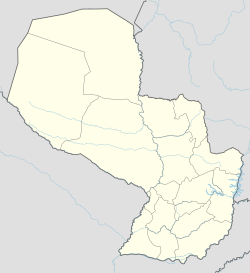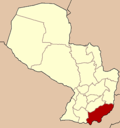Hohenau, Paraguay
 From Wikipedia - Reading time: 9 min
From Wikipedia - Reading time: 9 min
This article needs additional citations for verification. (December 2010) |
Hohenau | |
|---|---|
City and district | |
| Coordinates: 27°04′43″S 55°38′43″W / 27.07861°S 55.64528°W | |
| Country | |
| Department | Itapúa |
| Founded | March 14, 1900 |
| Founded by | Carlos Reverchon, Guillermo Closs, Ambrosio Scholler and Esteban Scholler, helped by German colonists |
| Area | |
• Total | 220 km2 (80 sq mi) |
| Population (2008) | |
• Total | 11,044 |
| • Density | 50/km2 (130/sq mi) |
| Time zone | UTC-4 |
| Postal code | 6290 |
| Area code | (595) (75) |
Hohenau is a city and district of the Itapúa Department, Paraguay, located 8 kilometers away from Trinidad and 365 kilometers away from Asunción. It has extensive cultivation fields and streams nearby like the Capi'ivary, Poromocó, Mansisovy, Santa María and others.
Name
[edit]The name comes from its elevated position sloping slightly downhill to the Paraná river, from the German hoch 'high' and Au(e) 'floodplain'.[citation needed]
History
[edit]The city was founded on March 14, 1900 by Carlos Reverchon, Guillermo Closs, Ambrosio Scholler and Esteban Scholler, helped by German colonists.[1][2] Founder Wilhelm (Guillermo) Closs, who was of German descent, was born on 31 October 1841 in Baumschneis, Brazil (today's Dois Irmãos).[3] Closs established a place called "Serra Pelada" in the state of Río Grande do Sul. Later, he decided to move to Paraguay, where he met Hohenau's future co-founder Reverchon. Together, they drafted plans for a massive wave of German immigrants to settle in the region.
Aided by the Austrian consul to Paraguay, they successfully persuaded the government to allow for the construction of a colony. By a decree dated September 12, 1898, the Paraguayan government gave Closs and Reverchon a share of 16 square leagues in the then Alto Paraná, Encarnación Department.
On March 14, 1900, the first settlers arrived from Encarnación. In August 1900, the arrival of 8 more families (a total of 55 people) set the stage for mass migration to the colony. Some of these first families were the Dresslers, Kuschels, Fritzes, Jachows, and others.
These families faced many problems, such as disease, scarcity of resources, and a lack of communication, which were gradually overcome. The town's status was elevated to an official district in 1944.
In the 1930s and '40s, the colony began to attract many non-Germans, such as Poles, Ukrainians, and Russians, and to a lesser degree Belgians and French. Later, in 1958, a large wave of Japanese arrived. These settlers then went on to found the district of La Paz.
Geography
[edit]The city is 220 square kilometers in area. It is bordered on the north and the east by the Obligado district, on the south by the Trinidad district, and on the west by the Jesús, La Paz, and San Pedro del Paraná districts.
It is located in a zone rich in hydrographic resources, with the Paraná river and the Capi'ivary stream.
Climate
[edit]The climate is sub-tropical, ideal for agriculture, with temperatures ranging from 3-4 °C in winter to 37-38 °C in summer.
Demography
[edit]Hohenau has a total population of 7,987 inhabitants.
Economy
[edit]The inhabitants are mainly focused on agriculture, specifically on the cultivation of soy, cotton, corn, manioc, yerba mate, tung, sorgo, citric, bean, peanut, and watermelon, and the stock breeding of cows, pigs and poultry.
There are also some small industries including flour mills, yerba mate mills, wineries, brick factories, bakeries, saw-mills, carpentry shops, and starch factories.
According to the General Directorate of Statistics, Polls, and Census, the Hohenau district has the second-highest living standard in Paraguay, behind the capital, Asunción.
Tourism
[edit]An important tourist attraction is the Alto Paraná Hunting and Fishing Club, where traditional dorado fishing takes place.
Among the other attractions this city offers are the German and Japanese colonies, where visitors can see unique architectural characteristics, typical foods, and cultivated fields.
Hohenau can be reached by the Ruta Sexta Doctor Juan León Mallorquín, a road that crosses the urban center of the city and connects it with the cities of Encarnación and Ciudad del Este. A network of local roads connects Hohenau with other places in the surrounding area.
Institutions
[edit]The city has a dance school, culinary arts academy, tailoring academy, barber academy, and other institutions that teach computer science and typewriting.
Medical institutions in the city include SOS Aldea de Niños, founded August 21, 1971 on land donated by the German Association of Hohenau with 17 buildings housing 160 children; the Mother and Child Hospital; the SOS Hospital with 40 beds and 2500 monthly consultations; and the Adventist Clinic that started its medical assistance service to the district and the department in 1963.
Neighborhoods
[edit]Center:
- San José
- San Blás
- Cerro Corá
- CONAVI
- Primavera
- Obrero
- Santa Lucía
Rural zone:
- Hohenau 1 (Puerto Hohenau)
- Hohenau 2 (Centro Urbano)
- Hohenau 3 (Campo Ángel)
- Hohenau 4 (Caguarené)
- Hohenau 5 (Santa María)
Notable residents
[edit]- Nazi war criminal Josef Mengele lived in hiding in Hohenau between 1959 and 1960.[4][5][6][7][8][9][10]
References
[edit]- ^ Fretz, J. Winfield (1962). Immigrant group settlements in Paraguay: A study in the sociology of colonization. North Newton, KS: Bethel College. p. 73.
- ^ Warren, Harris Gaylord; Warren, Katherine F. (1985). Rebirth of the Paraguayan Republic: the first Colorado era, 1878-1904. Pittsburgh: University of Pittsburgh Press. p. 266.
- ^ Ilg, Karl (1976). Pioniere in Argentinien, Chile, Paraguay und Venezuela: durch Bergwelt, Urwald u. Steppe erwanderte Volkskunde d. deutschsprachigen Siedler [Pioneers in Argentina, Chile, Paraguay and Venezuela: ethnology of the German settlers by journeying through the mountainsite, jungle, and steppe]. Innsbruck, Vienna, Munich: Tyrolia Verlag. p. 196. ISBN 3-7022-1233-7.
- ^ David F. Belnap (9 August 1979). "Mengele Hunt Focuses On Paraguay". The Washington Post. Washington, D.C. Retrieved 31 May 2024.
- ^ Art Harris (7 March 1985). "On the Trail of Mengele". The Washington Post. Washington, D.C. Retrieved 31 May 2024.
- ^ Henry Kamm (15 May 1985). "Wiesenthal Lists Mengele Sightings". The New York Times. New York. Retrieved 31 May 2024.
- ^ Pico Iyer (24 June 1985). "Searches the Mengele Mystery". Time. New York: Time Inc. Retrieved 31 May 2024.
- ^ Chicago Tribune (18 May 1986). "Fugitive". Chicago Tribune. Chicago, Illinois. Retrieved 31 May 2024.
- ^ James Brooke (1 June 1993). "Hohenau Journal; Sure, Mengele Was at Home Here, but Bormann?". The New York Times. New York. Retrieved 31 May 2024.
- ^ Graeme Wood (5 February 2008). "Mengele in Paraguay". The Smart Set. Philadelphia: Pennoni Honors College at Drexel University. Retrieved 31 May 2024.
- Reportaje al País. Tomo 1. Edición 2001. Asunción Paraguay.
- Geografía Ilustrada del Paraguay - ISBN 99925-68-04-6 - Distribuidora Arami S.R.L.
- La Magia de nuestra tierra. Fundación en Alianza. Asunción. 2007.
External links
[edit]- (in Spanish) Government Official Website
- (in Spanish) Official Tourist Information Website
- SENATUR
- World Gazeteer: Paraguay[dead link] – World-Gazetteer.com
 KSF
KSF

